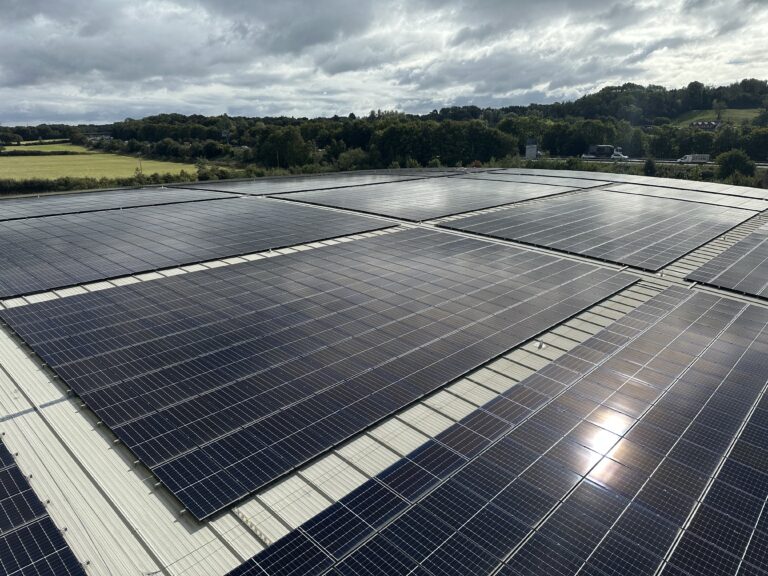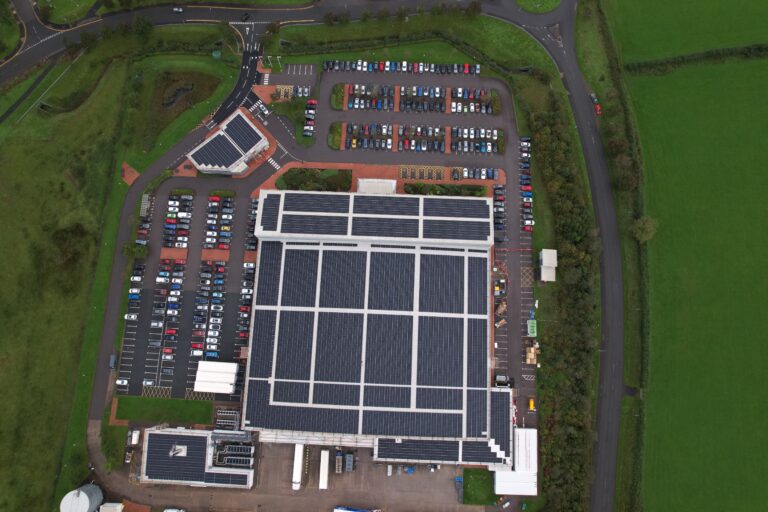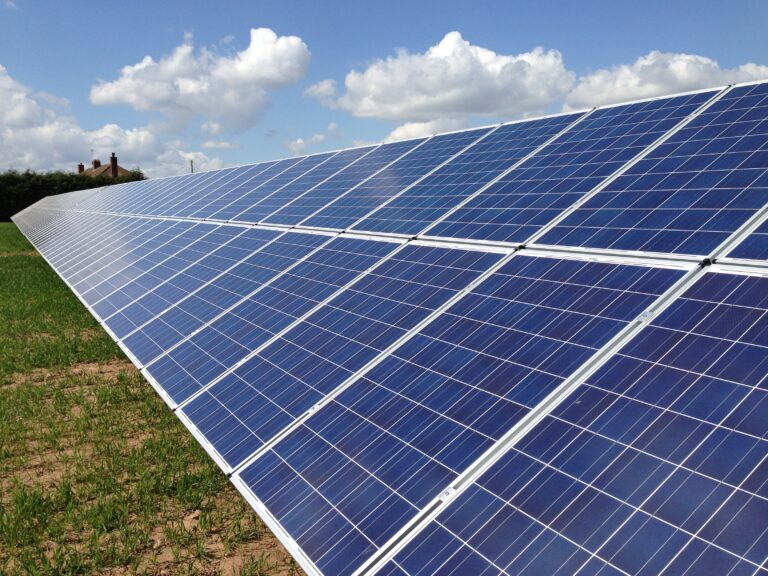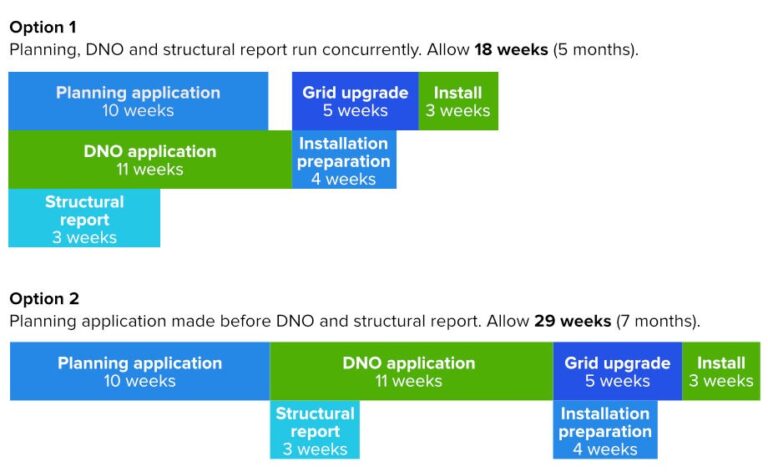Commercial Solar Installations - Permitted Development vs Planning Permission

Commercial Solar Installations Understanding Planning Permission
If you’re considering commercial solar installation for your business, one key question arises: Do you need planning permission? Here’s the quick answer: typically, no.
Most commercial solar power installations fall under Permitted Development, meaning you can often proceed without a planning application, if certain conditions are met. But there are essential limitations and exceptions, and knowing the rules ensures your project stays within regulatory bounds.
Permitted Development rights are designed to streamline certain building projects by allowing specific works without formal planning permission. These rights also incorporate protections for historically or culturally significant sites, making a project’s location and visibility potential factors for eligibility.
Here’s a comprehensive guide on when Permitted Development applies, the conditions your commercial solar project must meet, and instances when formal planning permission may still be necessary.
Determining If Your Commercial Solar Project Falls Under Permitted Development
In England, commercial solar projects are covered by Class J of the Town and Country Planning (General Permitted Development) (England) Order 2015. This regulation includes the installation, alteration, or replacement of:
✅ Microgeneration solar thermal equipment on a building.
✅ Microgeneration solar photovoltaic (PV) equipment on a building.
✅ Other solar PV equipment on the roof of nonresidential buildings.
For a commercial solar installation to be considered Permitted Development, specific conditions must be met, depending on whether the installation is roof mounted, wall mounted, or ground mounted

Roof Mounted Commercial Solar System Installations
Under Permitted Development regulations, commercial solar system installations that adhere to specific criteria can proceed without requiring planning permission. An update to these regulations in December 2023 removed the previous 1MW capacity limit, though other requirements remain unchanged. To qualify, roof-mounted commercial solar systems must meet the following guidelines:
1. Projection Limit:
Panels must not extend more than 200mm outward from the plane of the wall or roof.
2. Positioning:
Panels on both pitched and flat roofs must be positioned at least 1 meter from the building’s external edges.
3. Flat Roof Specifications:
Panels must not exceed 1 meter in height above the roof surface and cannot be the roof’s highest point (excluding any chimneys).
For ground-mounted arrays, installations should not exceed 9m² in area, 3 meters in any one direction, or 4 meters in height.
If your commercial solar system plans align with these criteria, installation can proceed under Permitted Development rights. However, consulting your local council is recommended to ensure full compliance.
Ground Mounted Commercial Solar Installations
Ground-mounted commercial solar installations are subject to specific guidelines to maintain aesthetic standards and minimise community impact. Here are the key requirements:
1. Area and Height Limitations:
Systems must not exceed a total area of 9 square meters and must remain below a height of 4 meters from the ground.
2. Single Installation Rule:
Only one ground-mounted system is allowed per building site.
3. Boundary and Location Requirements:
✅ Installations must be placed at least 5 meters away from the boundary of any listed building’s grounds.
✅ In conservation areas or World Heritage Sites, the system should not be visible from the highway.
✅ The system should not be installed within the grounds of a listed building.
Ground-mounted commercial solar systems generally require planning permission unless the array is smaller than 9 square meters and meets the above restrictions. It’s still advisable to verify with your local council, as interpretations can vary, especially for “standalone” systems, which typically refer to ground-mounted solar installations.

Additional Conditions for Commercial Solar Power Projects
Aside from specific mounting regulations, general conditions apply to all commercial solar power installations under Permitted Development:
✅ Visual Impact: Installations must minimise any negative visual impact on the building’s appearance and the surrounding area.
✅ Prior Approval for Additional Equipment: Any extra PV equipment beyond panels and brackets requires Prior Approval from the Local Planning Authority, including a 56-day notice period to assess the project’s impact on the building and vicinity.
✅ Landlord or Freeholder Permission: If the property is leased, permission from the landlord, freeholder, or management company may be required before proceeding.
✅ Building Regulations Compliance: Commercial Solar Installations must meet safety related building regulations, particularly Part A (structural safety) and Part P (electrical safety), ensuring the building can support the additional weight and that installations pose no risk to people or property.
When is Planning Permission Required for Commercial Solar Installations
While many commercial solar energy projects qualify as Permitted Development, certain conditions require formal planning permission. Here are the primary cases where planning permission applies:
✅ Listed Buildings: Any installation on a listed building or within its grounds (curtilage) requires planning permission.
Scheduled Ancient Monuments: If the proposed site is a scheduled ancient monument, permission is mandatory.
✅ Conservation Areas: Areas of Outstanding Natural Beauty and other designated conservation areas often have specific restrictions.
✅ Article 2(3) Land: If the property is on designated Article 2(3) land and the equipment will be installed on a wall or roof fronting a highway, permission is needed.
✅ Large Scale Installations: Roof mounted commercial solar systems with a capacity exceeding 1 megawatt (1 MW) require formal planning permission due to their potential impact on the surrounding area.
If your project falls within any of these categories, the local council will assess the application based on the installation’s impact on the building and surrounding area. While an application isn’t automatically rejected, approval isn’t guaranteed, as it depends on council discretion.
Prior Approval for High-Capacity Commercial Solar Systems
Commercial solar systems exceeding 50kW in capacity must obtain Prior Approval from the Local Planning Authority. This process, though less formal than full planning permission, includes an assessment of the design, appearance, and effects on neighboring properties.
In particular, the authority will review potential impacts such as reflective glare that could affect nearby properties or public spaces.
Timeline for Planning Permission
If planning permission is required, the process generally spans 10 to 11 weeks. Here’s a breakdown of the timeline:
✅ Application Preparation: It typically takes about two weeks to prepare a comprehensive application.
✅ Review Period: Once submitted, the planning department generally takes up to eight weeks to review the application and reach a decision. This timeframe can vary based on the proposal’s complexity and the council’s workload.
At Excel Energy, we’re here to provide tailored advice for your specific project, helping you understand the process and keeping you informed of any updates throughout the journey.
Applying For commercial solar power installation Planning Permission
Pre-Application Advice:
Before submitting a formal planning application for solar pv panels, it’s beneficial to seek pre-application advice from your local planning authority. This step can help you gauge the likelihood of approval for your proposed commercial solar power installation and highlight any potential issues that may require attention.
During the pre-application process, you’ll generally need to supply specific details about the proposed commercial solar project installation, such as its size, location, and design. The planning authority will review these aspects and provide feedback on any adjustments or concerns to address before submitting a formal application.
Submission Process:
After receiving pre-application advice and resolving any identified issues, you can proceed with submitting a formal planning application to your local planning authority. This application should include detailed plans, specifications of the proposed commercial solar project installation, and information on its potential impact on the surrounding environment and community.
The planning authority will then review your application, assessing its compliance with local regulations and potential effects on the area. The decision process can take several weeks or even months, depending on the proposal’s complexity and the planning authority’s current workload.
It’s crucial to note that failing to secure planning permission for a commercial solar system installation may lead to enforcement actions from the local planning authority, which could include requiring the removal of the panels. Following the correct planning procedures ensures that your commercial solar project installation is both legal and fully compliant with local regulations.
Commercial Solar System Installation: Key Steps and Potential Timeframes
Installing a commercial solar system involves several key steps, each with potential hurdles to address. Here’s a breakdown of the process and expected timelines:
1. Planning Permission (10-11 Weeks):
If required, the planning permission process includes a two-week period for preparing the application, followed by an eight-week wait for a decision from the planning department.
2. DNO Application (11 Weeks):
Installations exceeding 3.68 kWp (single-phase) or 11 kWp (three-phase) need approval from the Distribution Network Operator (DNO), such as Western Power or SSE. The DNO may approve the connection as-is or, in some cases, request upgrades to the grid, which may involve additional costs.
3. Grid Upgrades/3-Phase Connection (6+ Weeks):
If grid enhancements or a new 3-phase connection is necessary, this can add a minimum of six weeks, potentially extending further based on the operator’s timelines.
4. Structural Report (1-2 Weeks):
For roof-mounted installations, a structural assessment is required to confirm roof suitability. If minor strengthening is needed, it can often coincide with panel installation. Alternatively, opting for an in-roof system can reduce weight-related concerns.
We typically initiate planning permission, the DNO application, and the structural report simultaneously, allowing all processes to conclude within approximately 11 weeks. Installation generally begins 4-6 weeks post-planning approval, with a duration of 1-3 weeks for completion, making the overall timeframe around five months.
Optional Delay: To minimise costs if the planning application is rejected, we can delay the DNO application and structural report until after planning approval, extending the overall timeframe to approximately seven months.

Final Thoughts on Navigating Commercial Solar Installation Permits and Regulations
Understanding the regulations surrounding commercial solar installations is key to making informed decisions and avoiding delays. Permitted Development rights allow many projects to move forward without planning permission, enabling businesses to adopt renewable energy solutions with fewer hurdles. Yet it’s vital to understand the limitations of these rights and the situations that require formal permission.
For further information, the UK government’s website provides comprehensive resources on planning permissions for solar panel installations. Whether your project is largescale or small, a solid grasp of the regulations can make the path to solar energy smoother and more efficient.
At Excel Energy, our solar experts are committed to helping you meet your energy goals with ease. To discuss your commercial solar energy installation requirements, reach out to us on 0203 834 9440 and we’re here to support you every step of the way.
